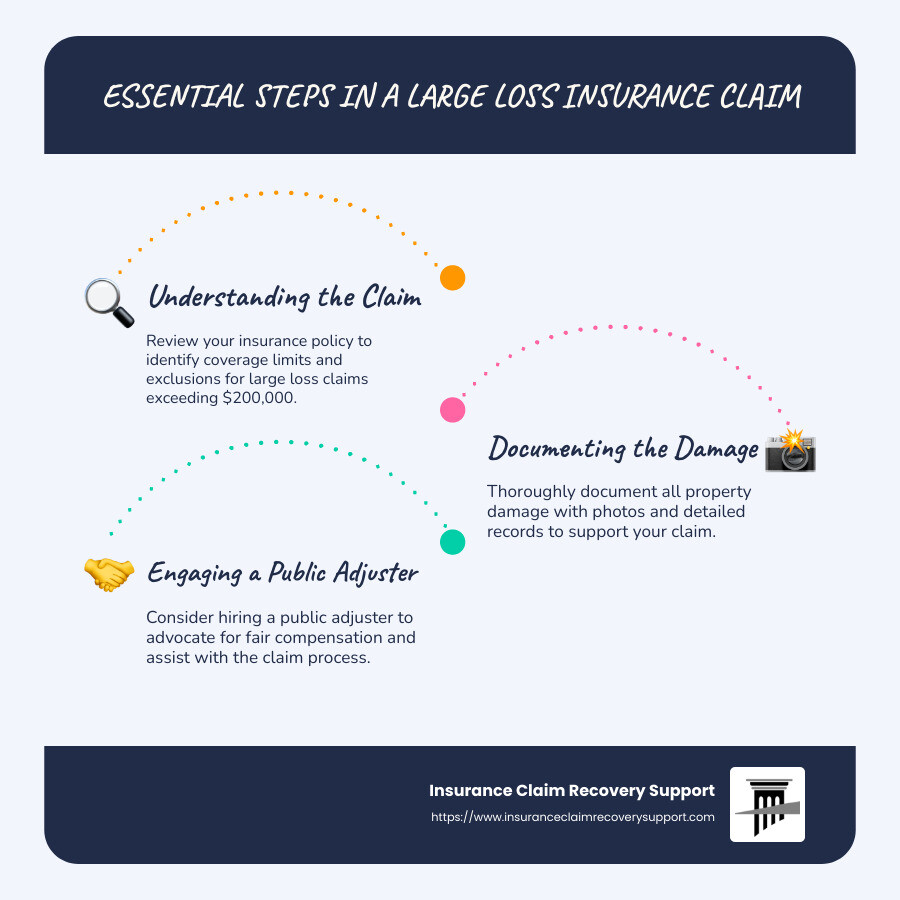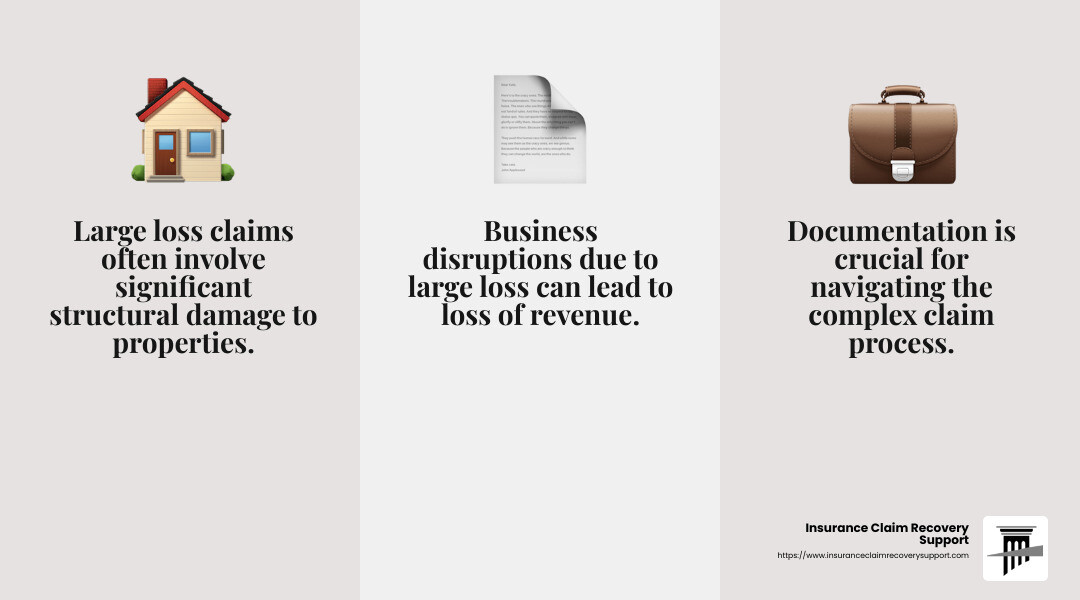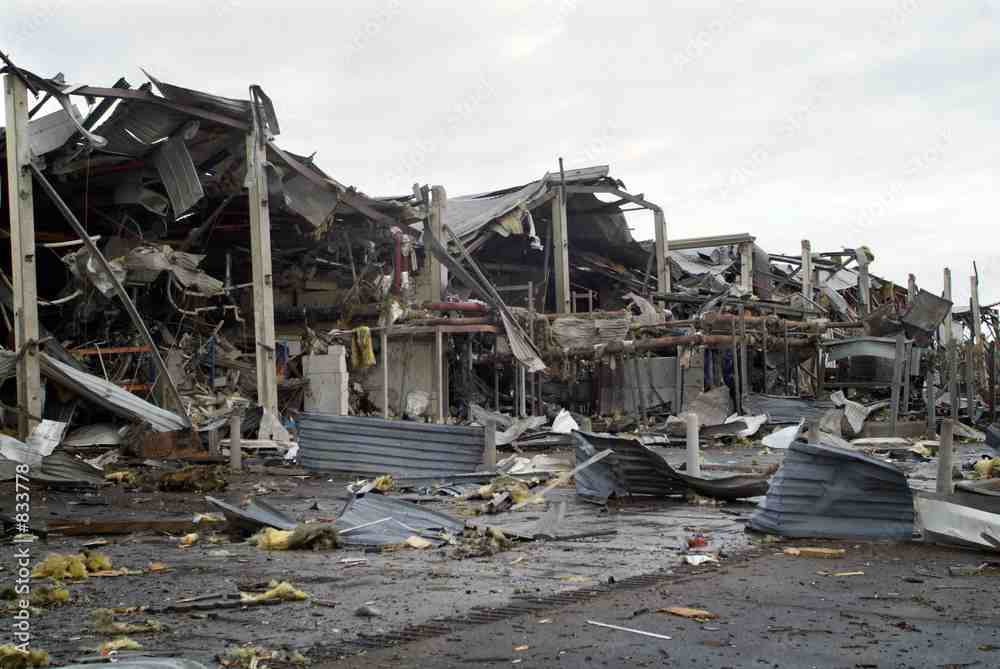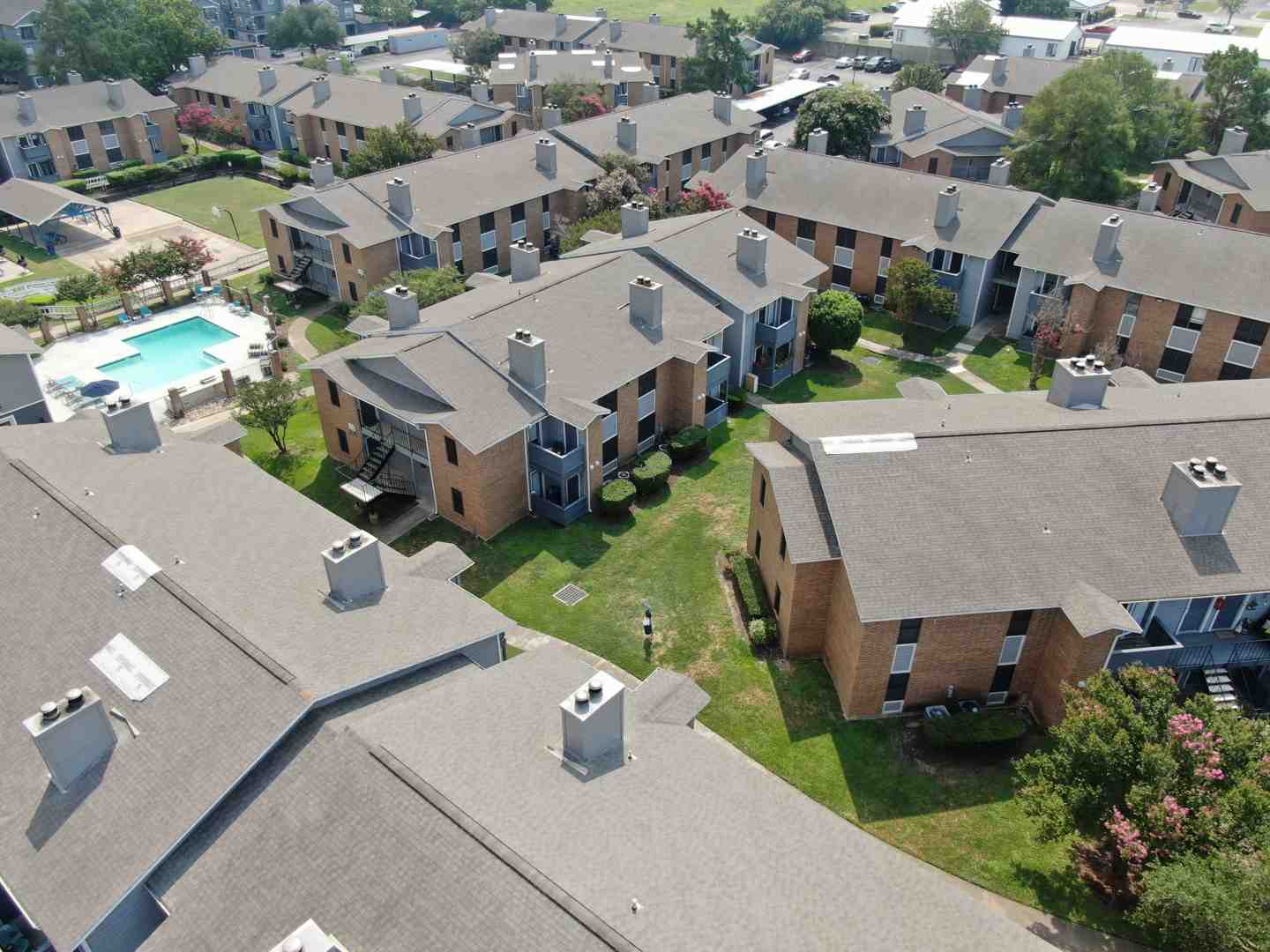Large loss insurance claim is a term often encountered by commercial property owners, multifamily complexes, and organizations struggling with the aftermath of substantial property damage. Typically, these claims arise when a property sustains significant damage exceeding $200,000, often due to catastrophic events like fires, hurricanes, floods, or tornadoes. Understanding the nuances of such a claim and navigating the insurance coverage process is crucial for recovering from these severe losses.
-
Definition: Insurance claims for property damage over $200,000.
-
Common Causes: Natural disasters like hurricanes, tornadoes, and floods; fires; vandalism.
-
Role of Public Adjusters: Professionals who advocate for fair compensation.
As we dig deeper into this guide, expect insights on key aspects of large loss insurance claims, from understanding your policy coverage to practical steps that ensure a fair settlement. It’s important to stay informed and prepared to manage the challenges of large property damages.
I’m Scott Friedson, a multi-state licensed public adjuster and CEO of Insurance Claim Recovery Support. Over my career, I’ve settled more than 500 large loss insurance claims, valued at over $250 million, including cases of underpayment and wrongful denial. This experience allows me to assist policyholders in attaining the compensation they rightly deserve.

What is a Large Loss Insurance Claim?
Elements of a Large Loss
When a property suffers significant damage, the process of filing a large loss insurance claim begins. These claims are crucial for property owners and businesses to understand because they often involve complex procedures and substantial financial stakes.
Significant Damage and Property Insurance
A large loss claim typically emerges when a property experiences damage that disrupts its operations or affects its structural integrity. Common triggers include natural disasters like hurricanes and floods, or accidents such as fires. For instance, during Hurricane Harvey, many properties in Texas faced extensive damages, leading to numerous large loss claims.
Property insurance aims to cover these substantial damages. However, the process isn’t always straightforward. Insurance policies can be intricate, with specific conditions and exclusions that policyholders must steer to ensure they receive the compensation they are entitled to.
Claim Process: Navigating the Complexities
The claim process for a large loss is more involved than standard claims. It begins with evaluating the damage and understanding the policy coverage. Documentation is key—this includes taking photos, gathering repair estimates, and keeping records of all communications. The complexity arises from the need to assess not only the visible damage but also the underlying structural issues.
Extensive Repairs and Structural Replacement
Large loss claims often involve extensive repairs or even structural replacements. For example, if a tornado damages a significant portion of an apartment complex, repairs might include rebuilding entire sections, replacing roofs, or addressing foundational issues. These repairs can be costly and time-consuming, requiring detailed estimates from contractors and engineers.
Business Impact: Beyond Physical Damage
The impact of a large loss extends beyond physical damage. For businesses, it can mean a halt in operations, loss of revenue, and additional expenses. Imagine a hospital that needs to shut down due to flood damage—it’s not just about repairing the building, but also about managing the loss of income and ensuring patient care continuity.
Understanding these elements helps in preparing for the challenges of filing a large loss insurance claim. It underscores the importance of being proactive and informed, ensuring that policyholders can effectively steer the process and secure the compensation needed to recover and rebuild.

Common Causes of Large Loss Claims
When it comes to large loss insurance claims, understanding the common causes can help you prepare and respond effectively. Here, we’ll explore the major culprits: natural disasters, fire damage, flood damage, and storm damage.
Natural Disasters
Natural disasters are one of the most significant causes of large loss claims. Events like hurricanes, tornadoes, and earthquakes can wreak havoc on properties, causing extensive damage. For example, Hurricane Harvey caused widespread destruction in Texas, leading to numerous large loss claims. The sheer scale of these disasters often means that entire buildings need repairs or even complete reconstruction.
Fire Damage
Fire is another major cause of large loss insurance claims. Fires can start from electrical faults, kitchen mishaps, or even arson. The damage from a fire is not limited to the flames—it often includes smoke and water damage from firefighting efforts. According to the National Fire Protection Association, there are over 100,000 non-residential building fires annually in the U.S., resulting in billions of dollars in damages. This highlights the importance of having comprehensive insurance coverage to address potential fire-related losses.
Flood Damage
Flood damage is notoriously excluded from standard property insurance policies, requiring separate flood insurance. Floods can occur due to heavy rains, storm surges, or river overflow, and they can devastate homes and businesses alike. The aftermath of a flood often involves dealing with waterlogged structures, damaged electrical systems, and ruined personal belongings. If you live in a flood-prone area, it’s crucial to have the right insurance coverage to protect against these types of losses.
Storm Damage
Storms, including those with high winds, hail, or lightning, can cause significant damage to properties. Roofs can be torn off, windows shattered, and trees uprooted, resulting in costly repairs. For instance, the 2021 Texas ice storms caused severe damage across the state, affecting everything from homes to vehicles. Understanding your insurance policy’s coverage for storm damage is essential to ensure you’re adequately protected when these events occur.
These common causes of large loss claims highlight the importance of being prepared and having the right insurance coverage. By understanding the potential risks, property owners can take proactive steps to protect their investments and ensure they are ready to steer the claims process when disaster strikes.
Navigating the Large Loss Insurance Claim Process
Dealing with a large loss insurance claim can feel overwhelming. The process involves several steps, and knowing what to expect can make it more manageable. One crucial aspect of this journey is understanding the role of public adjusters and how they can help you through the claim process.
Role of Public Adjusters
Public adjusters are your advocates in the insurance claim process. They work for you, not the insurance company, to ensure you get a fair settlement. Here’s how they help:
-
Claim Evaluation: Public adjusters start by evaluating the damage to your property. They conduct a thorough inspection to understand the full extent of the loss. This helps in creating an accurate estimate of the repair costs.
-
Documentation: Proper documentation is key. Public adjusters take detailed notes, photographs, and videos of the damage. They also gather necessary records like receipts and repair estimates. This documentation supports your claim and can speed up the process.
-
Advocacy: Acting as your advocate, a public adjuster communicates with the insurance company on your behalf. They understand the policy language and can argue effectively for your rights as a policyholder.
-
Negotiation: Insurance companies aim to minimize payouts. A public adjuster negotiates to ensure you receive the maximum settlement possible. They use their expertise to counter any lowball offers and push for a fair outcome.
At Insurance Claim Recovery Support, our public adjusters are experts in handling large loss claims. We focus on protecting your interests and maximizing your settlement. Whether you’re dealing with fire, flood, or storm damage, our team is here to guide you every step of the way.
By hiring a public adjuster, you have a professional on your side who understands the intricacies of insurance claims. Their support can make a significant difference in the outcome of your claim, helping you recover and rebuild with confidence.
Frequently Asked Questions about Large Loss Insurance Claims
What is considered a large loss claim?
A large loss insurance claim typically involves significant property damage exceeding $200,000. However, it’s not just about the dollar amount. The impact on business operations and the extent of repairs needed play a big role. For instance, if a small business has to halt operations due to severe damage, it could be considered a large loss even if the financial cost is relatively lower.
Key elements of a large loss claim include:
- Extensive damage to a large portion of the property.
- Complicated repairs required to restore the property.
- Significant impact on business output or operations.
Understanding these elements can help you determine if your situation qualifies as a large loss.
How do insurers handle large loss claims?
Insurance companies approach large loss claims with caution due to the substantial financial implications. Here’s a simplified breakdown of the process:
-
Assessment: Once a claim is filed, the insurer sends an adjuster to assess the damage. This is to verify the extent of the loss and estimate repair costs.
-
Documentation Review: Insurers require detailed documentation. They review photos, videos, repair estimates, and other evidence to support the claim.
-
Negotiation: Insurers often propose an initial settlement. This amount may be less than what you expect. It’s crucial to negotiate for a fair payout.
-
Settlement: After negotiations, a final settlement is reached. This should cover the repairs and any business interruption costs if applicable.
Tip: Having a public adjuster on your side can be beneficial. They advocate for you, ensuring the insurance company offers a fair settlement.
What should policyholders do after a large loss?
Experiencing a large loss can be distressing, but taking the right steps can help you recover more smoothly:
-
Document Everything: Take photos and videos of the damage. Keep records of all related expenses, like temporary repairs or accommodations.
-
Contact Your Insurer Promptly: Notify your insurance company as soon as possible to start the claim process.
-
Hire a Public Adjuster: They can assess the damage, document it thoroughly, and negotiate with your insurer on your behalf.
-
Review Your Policy: Understand your coverage limits and any exclusions. This knowledge can help you manage expectations and plan your next steps.
-
Stay Organized: Keep all claim-related documents, communications, and receipts in one place. This organization will be invaluable throughout the process.
By following these steps, policyholders can steer the aftermath of a large loss more effectively and work towards a fair settlement.
Conclusion
When it comes to large loss insurance claims, having the right support can make all the difference. At Insurance Claim Recovery Support, we are dedicated to advocating for policyholders and ensuring they receive the maximum settlement possible.
Policyholder Advocacy
Our role is to stand by your side throughout the entire claims process. We know how overwhelming it can be to deal with insurance companies, especially after significant property damage. Our public adjusters are experts in navigating the complexities of large loss claims, and we work exclusively for you, the policyholder.
We take the stress off your shoulders by handling everything from documenting the damage to negotiating with your insurance company. Our goal is to secure a fair and prompt settlement, so you can focus on rebuilding and moving forward.
Maximizing Settlements
Insurance companies often aim to minimize payouts, but we’re here to level the playing field. Our team carefully documents your claim, leveraging our deep understanding of insurance policies to negotiate effectively. We’ve helped many clients increase their settlement offers significantly, sometimes by over 200%.
Our commitment is to ensure you aren’t left to weather the storm alone. Whether you’re dealing with fire, flood, or storm damage, we have the expertise to help you recover what you’re entitled to.
In Texas, from Austin to Houston and beyond, we are known for our relentless advocacy and dedication to our clients. Let us be your partner in recovery, guiding you through the process and fighting for your rights every step of the way.
If you’re facing a large loss claim, don’t go it alone. Contact us today and let us help you steer the road to recovery.






